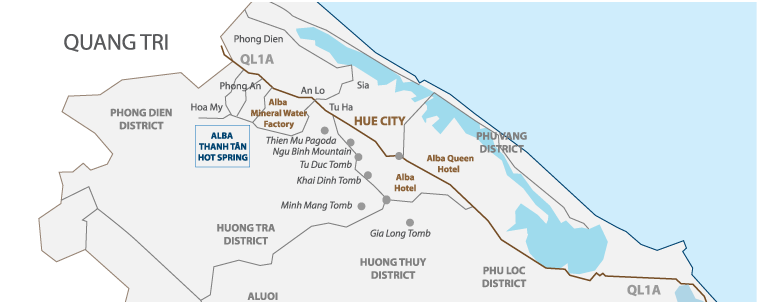LOCATION
Alba’s natural mineral water is bottled at source at the mineral hot springs of Thanh Tan, some 30km north-west of Hue. The location of this source has been well-known to locals for hundreds of years.
But it is only within the last 100 years that this natural heritage has been discovered and shared beyond the local area and its people.

ALBA HERITAGE
LOCAL HERITAGE
The virtues of Thanh Tân’s thermal waters were known to villagers and those from neigbouring areas for hundreds of years.
From the beginning of the 20th century, residents from nearby Hue would travel to the source to bathe in the mineral hot springs.
They believed that by bathing at Thanh Tan many of their ailments would diminish and the reputation of the health benefits of this water source quickly spread. However, at that time, the local people were unaware that the therapeutic virtues of the natural mineral water were linked to its mineral composition.
FRENCH DISCOVERY

In 1928, Thanh Tân was officially ‘discovered’ by a French scientist, Dr. Albert Sallet (1877-1948).
Dr. Sallet was well-known for being ‘in love’ with many aspects of Vietnamese culture. After his service in the army, he remained in Annam (the French colonialists name for Central Vietnam) for more than 20 years to conduct research in diverse fields, which included geology, herbal and traditional phamacy.
In 1928, his article “Au sujet des sources thermominérales de l’Annam” (About the thermo-mineral source of Annam) was published in the prestigious Bulletin de la Société des ÉtudesIndochinoises (Journal of the Society of Indochinese Studies). Albert Sallethad identified Thanh Tan as a source of thermo-mineral water.
SCIENTIFIC DISCOVERY
The scientific evidence about Thanh Tân’s mineral water properties was first revealed in 1957 by Henri Fontaine (1924-).
A missionary from the Mission Étrangère de Paris (MEP), Henri Fontaine is also an eminent geologist who, during his 24 years working in Vietnam and South East Asia, from 1951 to 1975, conducted important studies about Vietnam’s geology. In 1957, while working for the Geological Service ofthe Ministry of Economy in Saigon, he published his article Les sources thermominérales du Vietnam méridien (The thermomineral sources of South Vietnam) in the journal Archives Géologiques du Vietnam (Archives of Vietnam Geology).
Based on the analysis of the samples carried out by Henri Fontaine, the mineral composition of the water bottled at the Thanh Tan source could be specified as a mixture of sulphated, calcic and bicarbonate while the temperature of the water varies between 56⁰C and 66 ⁰C.
In the years since the original discoveries, the Thanh Tân source has been explored repeatedly, in 1973 by Czechoslovak geologists, and in 1980 and 1992 by Vietnamese geologists. All the analysis results showed its stable composition, compared to those published by H. Fontaine, while the highest temperature recorded at the main emergence was 68⁰C.
RECENT DEVELOPMENTS
In 1983, the Ministry of Health announced that the Thanh Tân source could be exploited both to produce bottled natural mineral water and to use for the health benefits of its mineral hot springs. By 1986, the Thua Thien Hue Pharmaceutical company had built a factory to bottle water from the source and that year ThanhTân natural mineral water first appeared on the market.
In 1998, the Thanh Tân Joint Stock Company was founded, which incorporated both the bottling factory and the rights to exploit the thermal source of the mineral hot springs, including the surrounding 50 hectare site.
Pharmacist Lê Thị Châu (1941-2012) became the Company Chairwoman. Her deep love of nature combined with her vast experience in the health sector, allowed her to envision an enterprise that exceeded simply bottling mineral water. She wanted to make Thanh Tân a tourist destination, where the mineral hot springs with their supply minerals could be used for their specific therapeutic properties. Under Ms. Châu’s leadership, significant works have been carried out to transform the infertile soil and deforested hills, remnants of war time, into today’s green and floral Alba Hot Springs Resort.
MINERAL PROPERTIES
Heated by volcanic magma, enriched in magnesium, calcium, phosphorus, while traveling through earth layers of the Truong Son mountain chains, Alba natural mineral water contains a variety of mineral properties which aid health and well-being.
![]() Bicarbonates neutralize gastric acidity and improve digestion.
Bicarbonates neutralize gastric acidity and improve digestion.
![]() High concentrations of calcium and magnesium can be easily absorbed by the body, help regulate your heartbeat and are necessary for bone strengthening and muscle activity as well as preventing female osteoporosis.
High concentrations of calcium and magnesium can be easily absorbed by the body, help regulate your heartbeat and are necessary for bone strengthening and muscle activity as well as preventing female osteoporosis.
![]() Sodium helps balance brain activity, while regulating muscle and heart stimulation. The low concentration of sodium in alba natural mineral water is good for people suffering hypertension.
Sodium helps balance brain activity, while regulating muscle and heart stimulation. The low concentration of sodium in alba natural mineral water is good for people suffering hypertension.
![]()
Potassium together with sodium regulate blood tension and when combined with magnesium can help regulate heart activity, stimulating your metabolism and improving oxygen supply to the brain.
![]()
Sulfate improves intestinal transition and consequently detoxification and prevents constipation.
![]()
Silicic acid is known for its important role in bone and cartilage disc formation and strengthening, necessary for joint tissues, hair and nails.
![]()
Bicarbonate helps to neutralise gastric acid, which is good for people suffering chronic stomach trouble as well as liver and pancreatic diseases.
![]()
The optimum level of Florine in Alba natural mineral water helps balance bone structure, and prevents dental carries, atherosclerosis and female osteoporosis.









